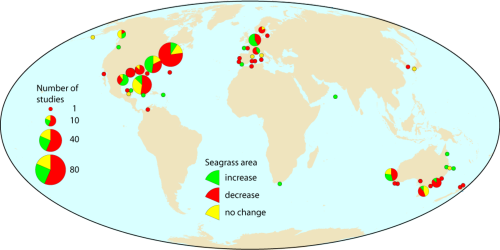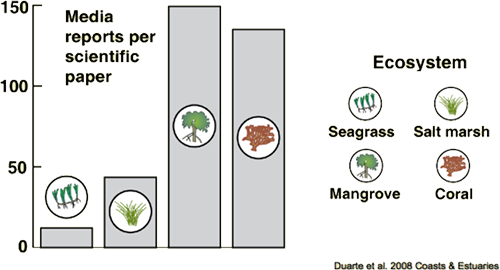Brisbane 2011: Living with Floods and Dancing with Dugongs: Part 12- Charismatic Environmental Initiatives
Bill Dennison ·Globally, seagrasses are a good indicator of ecosystem health, and so we have gone and put a global database together and started analyzing this and we've written a bunch of papers. This is one of the graphics from a paper showing that there is a preponderance of seagrass area data in North America, Europe and Australia.

Not so much in the rest of the world. Now that's starting to come in with these volunteer programs: Seagrass-Watch and SeagrassNet. But, we're seeing that the declines outweigh the gains, and even the 'no change'. That's just for total area. We've also done this for seagrass biomass, cover, and density. The other thing that's important is that the magnitude of the declines outweighs the magnitude of the gains. So generally seagrasses are hurting, as much as mangroves, coral reefs or any other coastal systems. We got to thinking "Why don't more people know about this? Why is this such a hidden story?" We then started thinking that we might have a charisma gap. So we analyzed that by going around the world and getting the Bombay paper, the London Times, National Geographic, the New York Times and other media reports we collected from around the world of seagrasses, salt marshes, corals and mangroves. We found out that for every publication about seagrasses you got about 10 media hits associated with that, but for corals and mangroves you got 140 or 150 media hits, an order of magnitude more media reports. So these ecosystems have a lot more charisma then our lowly seagrasses, and we got to thinking, "Why is that? Why do they have all the charisma and seagrasses have none?

The first conservation movement was charismatic megafauna. We had the panda, WWF's logo. We have Save the Whales. So these are big, iconic creatures that we care about. Charismatic megafauna is how we 'term' them. Now we have converted into charismatic ecosystems. I was teaching a class of first-years and I did a survey at the beginning of the class. What is the most important problem? Tropical rainforest deforestation was number one. These kids have never been to a tropical rainforest. They had no idea, but they thought they were important. So, tropical rainforests had made it. The Canadian Organization for Tropical Education and Rainforest Conservation is just an example. Canada does not have a lot of rainforests, and it's kind of cold, and kind of white most of the time, yet they have embraced tropical rainforests. Mitsubishi, a car company, has put on a coral reef conservation challenge. So these are fantastic. They've made these ecosystems charismatic, but we need to make other ecosystems charismatic, too, so we can look for these integrated impacts of floods or other events.
How do we make seagrasses charismatic? Peter Oliver from the International WaterCentre figured that out. This is Peter dancing with Mark Pascoe and Kate Moore and a few other individuals. He set up a competition for people to make videos about Dugongs using music. So there are "Dugong Rock" videos that have now been produced in Indonesia and the coast of Queensland. So you can go to YouTube and watch the "Dugong Rock" being performed by these various people. So that's a very exciting opportunity to use dugongs as a conservation icon. Of course dugongs eat seagrass exclusively. So that's a great opportunity to celebrate these less charismatic ecosystems.
This blog post was created from a presentation by Bill Dennison, delivered at the historic Customs House in Brisbane, Australia on 8 July, 2011 (see previous blog posts). The full powerpoint presentation can be accessed on IAN Press.
About the author
Bill Dennison

Dr. Bill Dennison is a Professor of Marine Science and Interim President at the University of Maryland Center for Environmental Science (UMCES).